Quick Summary:
Thrive with the Adaptive Software Development (ASD) model with its continuous cycle of speculation, collaboration and learning as it encourages teams to adapt their strategies and design seamless software. The article covers the lifecycle of ASD, advantages, characteristics, tips, its comparison to other methodologies, challenges and how Decipher Zone can help you implement in your software development process.
Change is inevitable and software development is no exception in this fast-paced world of technology. Traditional rigid methodologies often fall short in the rapid shift requirements, market fluctuations and evolving user expectations. That’s where Adaptive Software Development (ASD) steps in.
Originally introduced by Jim Highsmith in the 1990s Adaptive Software Development model is a dynamic and flexible methodology designed to thrive in environments of rapid change and uncertainty.
Unlike linear models that demand detailed planning upfront ASD embraces a continuous cycle of speculation, collaboration and learning. It encourages teams to adapt their strategies as projects unfold, boosting innovation, improving responsiveness and ensuring that the end product aligns closely with real-world needs.
Adaptive Software development has become a foundational influence in modern agile practice with its emphasis on iterative development, stakeholder engagement and risk management. You may wonder how does the software development benefits from the ASD methodology? This blog addresses all your questions so stay tuned!
Adaptive Software Development (ASD) Explained: A Comprehensive Guide
Adaptive Software Development (ASD) is a modern and flexible software development methodology designed for one key purpose “to embrace“ change. Rigid workflows and static plans often become outdated before a product reaches the market.
This is where ASD provides a flexible, iterative and highly collaborative approach that allows development teams to respond swiftly to evolving customer needs and shifting market demands.
At Decipher Zone we view ASD as more than just a methodology. It is a mindset that is rooted in the principles of Agile. This method encourages teams to develop software incrementally, incorporating continuous feedback and real-world insights throughout the development lifecycle.
This enables frequent course corrections and ensures the final product is aligned with real user expectations and not just initial assumptions. The essence philosophy of ASD is based on three interrelated stages:
-
Speculate: Teams speculate the best possible direction based on current knowledge instead of restricted and rigid planning.
-
Collaborate: To refine features and uncover real needs developers, stakeholders and customers work closely together, enhancing the harmony and working quality.
-
Learn: Every iteration provides valuable feedback that turns experience into actionable knowledge for future cycles.
This customer-centric approach fosters innovation and agility which makes it particularly effective for complex or uncertain projects where requirements are likely to change. We ensure that each iteration reflects user priorities, minimizes risk and maximizes value by involving clients early and often.
Mainly, Adaptive software development empowers businesses to build solutions that are not just functional but resilient and ready for the future.
Adaptive Software Development (ASD) Lifestyle
The Adaptive Software Development (ASD) lifecycle is a modern, iterative approach designed to address the unpredictability and complexity of software projects. It evolved from the spiral model of the 1980s despite of its iterative nature but still relied heavily on predictability and control. ASD breaks away from the traditional mindset by fully embracing change, uncertainty and learning as core elements of the development process.
Read: Tools and Platforms for Software Development
The adaptive lifecycle encourages teams to speculate, collaborate and learn rather than following a rigid, linear path. Here are three dynamic phases that align with the ever-changing nature of real-world software projects:
1. Speculation
While this phase may resemble traditional planning, speculation goes beyond creating timelines and task lists. This means that adaptive software development acknowledged the volatile nature of software projects considering the various stakeholders of the project. This makes it different from the typical planning stage as speculation enables coping up with uncertainties.
At Decipher Zone, we approach this phase with flexibility and foresight recognizing that change is inevitable. In the speculation phase, our teams:
-
Define a clear goal statement based on the current understanding of the project.
-
Build consensus among stakeholders around high-level goals and desired outcomes.
-
Strategize for change by embedding adaptability into every part of the plan.
This proactive and open-ended approach ensures we are not just planning for what’s known but also what’s not.

2. Collaboration
Once the groundwork is laid, we enter the Collaboration phase where ideas start transforming into real, functional software. Whatever stakeholders agreed on during the speculation phase is implemented in this phase. Cross-functional teams bring all the expertise and resources to a platform and develop more robust and secure business applications.
While traditional software development involves predefined responsibilities and rigid workflows, Adaptive Software Development (ASD) promotes real-time collaboration, ongoing communication and rapid iterations.
Here cross functional teams at Decipher Zone work in close alignment fostering a culture of shared ownership and continuous communication. During this collaboration phase:
-
Developers, testers, UX designers and stakeholders work closely together to ensure effective coordination.
-
We focus on building the core functionality while keeping the architecture flexible.
-
The environment encourages feedback loops which help teams to respond quickly to evolving requirements or technical changes.
-
The final product ensures that what true collaboration sounds like it may not only technically sound but also be closely aligned with the client’s vision.
3. Learning
The final phase, Learning where the magic of ASD turns unfolds. The software development teams conduct short iterations of cycles (designing, building and testing). These iterations are viable for gathering knowledge through a loop of minor errors and their rectifications.
Identifying and correcting errors is a crucial method for developing robust code with minimal or no errors. The team’s performance is evaluated to assess the areas of improvement. When hiring a software developer consider those with proven expertise in the ASD model as they are better equipped to build high-quality software solutions.
Rather than waiting until project completion to evaluate success we embrace a short iterative cycle to continuously test, learn and adapt. In this phase, we:
-
Perform quick design, build and test loops to surface issues early.
-
Analyze errors, collect feedback and refine the product with each iteration.
-
Evaluate team performance to unlock opportunities and areas of improvement
This continuous learning loop doesn’t just improve the product but it enhances the process itself shaping the way to higher quality, greater efficiency and long-term project success.
7 Key Functions of Adaptive Software Development (ASD)
Adaptive Software Development (ASD) embraces uncertainty and transforms it into strategic advantages through its distinctive characteristics.
Here is the detailed explanation of key functions of adeptive software development.
-
Mission-Focused
-
Feature-Based
-
Iteration
-
Time-Based
-
Risk-Driven
-
Change-Tolerant
-
Ownership & Empowerment
1. Mission-Focused
ASD prioritizes outcomes over tasks rather than rigidly adhering to predefined requirements. Development teams align all activities with the overarching mission or goals of the project. In early stages when requirements are often ambiguous a mission statement provides direction.
As the project progresses all decisions are evaluated against this mission. This ensures the team stays on track while remaining open to adaptation.
2. Feature-Based
Development is structured around delivering functional features that users can interact with, test and provide feedback on as in ASD application features are the primary unit of progress.
By focusing on high-priority features first development team ensures that each iteration delivers meaningful value. Features evolve based on iterative learning. This helps the final product better align with actual user needs.
3. Iteration
Iteration is the heartbeat of ASD as it allows teams to refine both the software and their approach over time. Each cycle includes planning, designing, building and testing activities.
This repetition process surfaces insights early and often instead of waiting for the final release to uncover flaws or misaligned expectations. This promotes continuous improvement throughout the project.
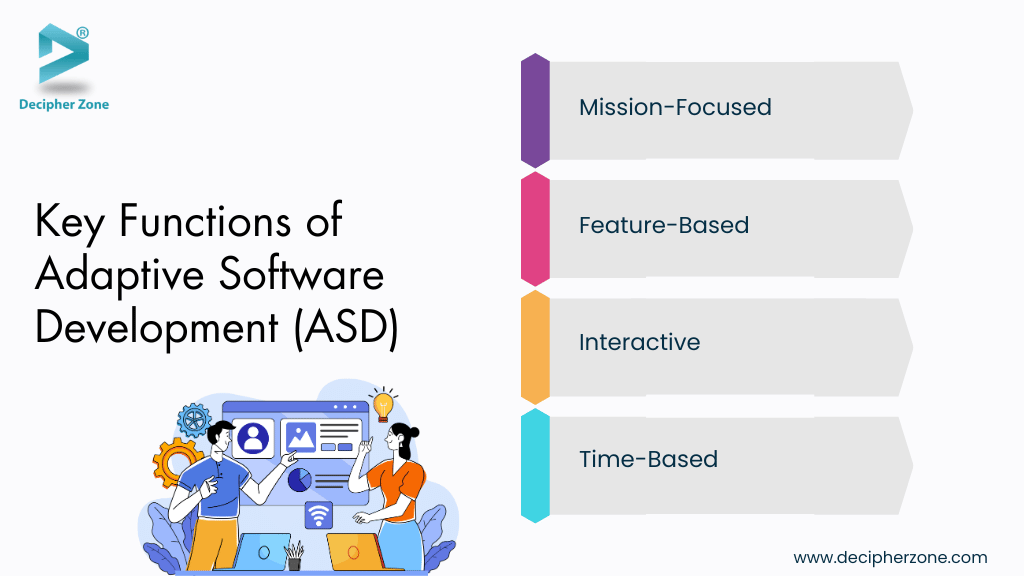
4. Time-Based
ASD employs timeboxing fixed periods mainly 1-4 weeks for completing specific tasks or iterations to maintain momentum and manage complexity. This structure ensures consistent delivery of progress that encourages focused teamwork and helps manage scope.
With clear deadlines teams can prioritize what matters most and reduce the risks of scope creep or prolonged decision making.
5. Risk-Driven
ASD embraces a risk-driven behavior instead of avoiding or ignoring potential issues. Each iteration is approached with a clear understanding of the possible challenges whether they are technical hurdles, shifting requirements or stakeholder concerns. Identifying and addressing these risks early allows teams to take proactive measures. This minimises the chance of project derailment.
6. Change-Tolerant
New insights, shifting business goals or evolving users needs are not seen as threats but as opportunities for improvement. The most defining trait of adaptive software development is its tolerance and even encouragement of change.
The methodology’s flexible structure enables teams to easily integrate changes into upcoming iterations which ensures the final product remains relevant and user-centric.
.avif)
7. Ownership & Empowerment
Software development teams have more freedom in assuming ownership and making decisions at the team level. This approach not only boosts a sense of accountability but also enhances the team's responsiveness to challenges and opportunities.
Together these characteristics form the backbone of adaptive software development. They promote a development environment where uncertainty is not feared but embraced and where continuous feedback and learning lead to better outcomes.
Read: Popular Types of Software Development
5 Benefits of Adaptive Software Development (ASD)
Here are the advantages of adopting the adaptive software development (ASD) approach:
-
Faster Time-to-Market
-
Improved Collaboration and Teamwork
-
Customer-Centric Development
-
Continuous Improvement
-
Reduced Project Risk
Businesses can no longer afford a slow inflexible software development method. With ASD abilities dynamic and flexible empowered organizations to move faster, collaborate better and build products that genuinely meet user needs.
1. Faster Time-to-Market
The development of new applications or features no longer requires extensive timeframes. ASD promotes shorter development cycles by breaking the work into smaller functional increments. Businesses introduce new features as each release delivers tangible value.
This speed not only keeps customers engaged but also enables companies to capitalize quickly on market opportunities.
Our teams at Decipher Zone leverage the ASD methodology to help clients accelerate their product development without compromising on quality giving them a critical edge in fast-paced industries including healthcare, education, fintech and real-estate.
2. Improved Collaboration and Teamwork
ASD empowers collaboration between teams (developers, designers, product managers and stakeholders), allowing them to work together to quickly identify and address potential issues.
This not only boosts shared ownership and better communication but also provides a more cohesive transparent development process, where all voices are heard and solutions are built collaboratively.
Our teams are structured to maximize collaboration ensuring that diverse perspectives contribute to building products that are robust, user-centric and innovative.
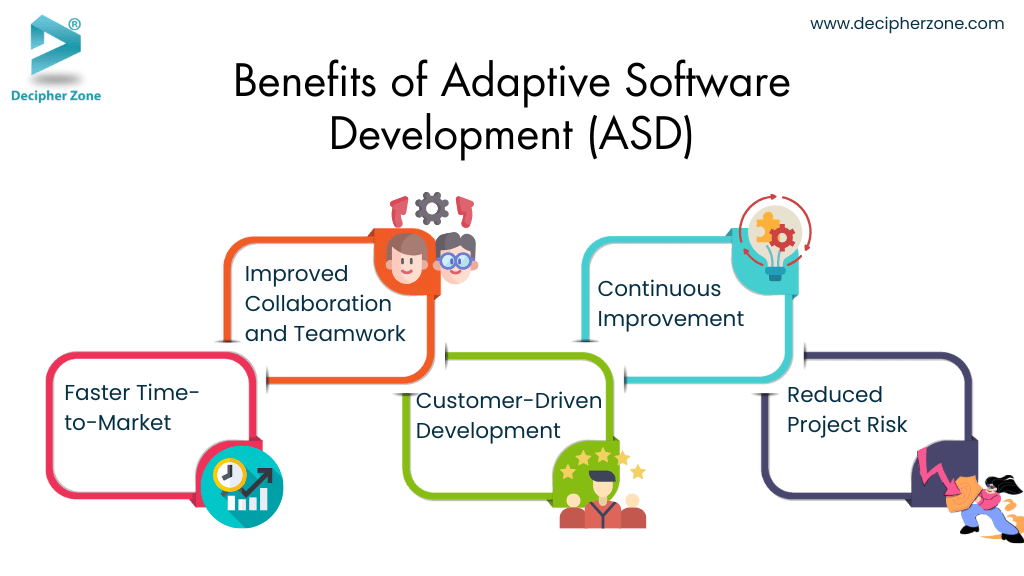
3. Customer-Centric Development
Every iteration encourages user feedback which directs change and areas of improvement as continuous feedback is essential in ASD. This ensures that the software remains aligned with the real customer requirements rather than assumptions made early in the development of the project. It leads to higher customer satisfaction and loyalty.
Our team doesn’t just welcome customer feedback but it’s woven into every stage of development that ensure that the final product resonates with the target audience.
4. Continuous Improvement
ASD mainly promotes a mindset of ongoing learning and areas of improvement. Every iteration has enhancements. This continuous cycle leads to products that get better and more polished with every release which helps the product remain relevant and competitive over time.
Our team embraces this philosophy which ensures that every iteration is an opportunity to not just build, but to build better.
5. Reduced Project Risk
Teams can identify and address risks earlier by working iteratively and delivering functional components of the product sooner. Before the problems escalates they are identified and resolved. This proactive approach to risk management makes adaptive software development a safer and smarter choice for mission-critical software initiatives.
With a proven track record in risk-aware development practices, our team helps organizations minimize project uncertainties and deliver successful outcomes.
6 Best Practices to Implement Adaptive Software Development (ASD)
Here are some practical and effective best practices to help you implement adaptive software development (ASD) in your development workflow:
-
Bring Your Team and Stakeholders on Board Early
-
Encourage Strong Cross-Functional Collaboration
-
Foster a “Fail Fast, Learn Fast” Culture
-
Balance Adaptability with Strategic Planning
-
Put the Customer at the Center
-
Equip Your Team With the Right Infrastructure
Businesses need to establish a culture that embraces flexibility, learning and continuous collaboration.
1. Bring Your Team and Stakeholders on Board Early
Nothing significant is likely to happen unless your team is actively involved. So it’s really important you to bring them onboard, gain the trust and buy-in of your core team and key stakeholders from early on and show them what they are missing out on.
Help them understand what ASD is, how it benefits their work and how it aligns with your broader business goals. Highlight success stories and areas of improvement from your current process that ASD could solve.
Read: How to Ensure Quality Software Development
2. Encourage Strong Cross-Functional Collaboration
ASD thrives on the collaboration between cross-disciplinary teams. To encourage greater team collaboration, consider breaking down the silos between designers, developers, testers and product managers. Introduce shared goals and create an environment where everyone contributes to product decisions and outcomes.
Tools like Jira, Slack, Microsoft Teams and Miro can improve transparency streamline communication and support real-time collaboration across locations and time zones.
You are not just developing code, you’re building a shared understanding of user needs and how to deliver value together.
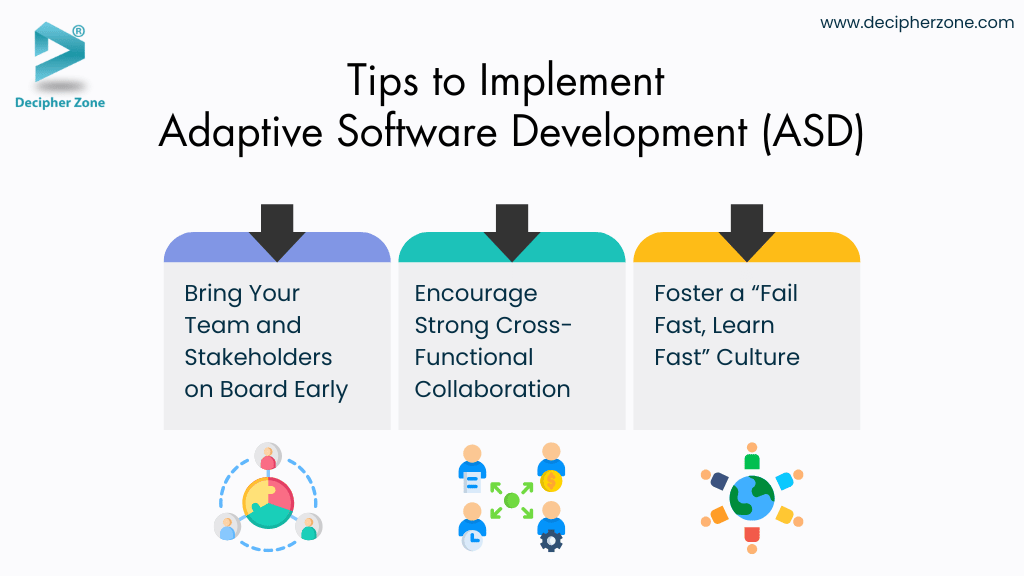
3. Foster a “Fail Fast, Learn Fast” Culture
In ASD all the failures or mistakes are learning opportunities. Encourage your teams to experiment, test bold ideas and iterate quickly. By reframing failures as feedback businesses can reduce the fear of taking risks and promote innovation.
By establishing short feedback loops and retrospectives team can reflect and adjust after every cycle. The faster you learn, the faster your product improves.
4. Balance Adaptability with Strategic Planning
In the ASD model teams are trained to welcome change but that doesn’t mean operating without direction. It’s beneficial to create and follow a clear yet flexible roadmap to stay focused. Establish clear goals for each iteration while being open to change based on new insights or evolving customer needs. This balance helps teams stay focused without becoming rigid.
.avif)
5. Put the Customer at the Center
ASD focuses on delivering value to end customers. Gather user feedback regularly whether through surveys, usability testing or direct communication. Involve end users in the iteration cycle in the development process wherever possible.
Use real-world use cases and needs to shape your feature priorities rather than relying solely on internal assumptions. This ensures that every version of your product aligns more with your users needs.
6. Equip Your Team With the Right Infrastructure
To fully support the ASD process ensure your team has access to the right infrastructure. Use Git (via Github, GitLab or Bitbucket) for version control, and set up CI/CD pipelines with tools like Jenkins or GitLab CI for automated testing and deployment. Plan and manage iterations using Jira or Trello and enable real-time collaboration through Slack or Microsoft Teams.
For testing you can leverage Selenium, JUnit or Postman to ensure product quality throughout the lifecycle. These tools not only help streamline development, boost agility and support continuous improvement core to Adaptivre Software Development but also improve transparency helping your team to stay fast, flexible and focused.
Adaptive Software Development (ASD) vs. Other Methodologies
It’s important to understand how Adaptive Software Development (ASD) compares to other popular software development methodologies. Below is a detailed comparison of various methodologies highlighting the pros and cons of each approach:

Adaptive Software Development (ASD) vs. Feature-Driven Development (FDD)
Flexibility and Adaptation:
ASD outshines in adapting to evolving requirements and encourages teams to learn from every iteration. It thrives in environments where change is constant. Whereas FDD follows a more organized path focusing on building features based on a predetermined list. It is less open to frequent change than ASD while iterations.
Component vs. Feature-Based:
ASD is component-driven which focuses on emergent design and adaptability whereas FDD is feature-based which prioritizes building and delivering specific features outlined during the planning phase.
|
Methodologies |
Pros |
Cons |
|
Adaptive Software Development (ASD) |
|
|
|
Feature-Driven Development (FDD) |
|
|
Adaptive Software Development (ASD) vs. Extreme Programming (XP)
Customer Collaboration:
ASD focuses on continuous customer feedback loops and client collaboration across cycles whereas XP mandates client collaboration by immerse the customer directly into the development team.
Quality and Iteration:
Both ASD and XP focus on quality through iterations. But XP puts a heavy focus on technical practices such as pair programming test-driven development (TDD) and continuous integration more than ASD.
|
Methodologies |
Pros |
Cons |
|
Adaptive Software Development (ASD) |
|
|
|
Extreme Programming (XP) |
|
|
Adaptive Software Development (ASD) vs. Rapid Application Development (RAD)
Iteration and Speed:
Both ASD and RAD prioritize short cycles and quick development. RAD focuses on rapid prototyping and user feedback where as ASD takes it a step further by focusing on continuous learning and adaptability throughout the process.
Feedback Mechanism:
ASD uses real-time feedback across iterations to ensure the improvements required in the final product to make it effective and more customer-centric whereas RAD gathers user input primarily through prototype evaluations.
|
Methodologies |
Pros |
Cons |
|
Adaptive Software Development (ASD) |
|
|
|
Rapid Application Development (RAD) |
|
|
Adaptive Software Development (ASD) vs. Scrum
Structure and Roles:
ASD is less prescriptive that allowing teams to self-organize and adapt processes as needed whereas Scrum defines strict roles including Product Owner, Scrum master, Developers and time-based sprints.
Focus:
ASD focuses on adaptability and learning whereas Scrum focuses on delivering incremental value through sprints and well-defined backlogs.
|
Methodologies |
Pros |
Cons |
|
Adaptive Software Development (ASD) |
|
|
|
Scrum |
|
|
6 Common Challenges in Implementing Adaptive Software Development (ASD)
Adaptive Software Development (ASD) offers flexibility and faster delivery replacing traditional software development approaches in recent years. While there are several benefits to adopting this innovative approach teams also face a unique set of challenges.
Understanding and addressing these roadblocks is key to utilizing the full potential of ASD.
-
Finding the Right Team
-
Establishing Clear Goals
-
Managing Change
-
Ensuring Quality and Testing
-
Facilitating Clear Communication
-
Managing Uncertainty
Read: Common Myths About Software Development
1. Finding the Right Team
ASD requires a cross-functional team that excels not only in technical but also in collaborative problem-solving and decision making expertise. Choosing well rounded team can be tough.
This is where Decipher Zone can help. We offer access to experienced developers, testers and project managers who are well versed in agile and adaptive practices which ensures your project has the right minds on board from the outset.
2. Establishing Clear Goals
ASD requires clear goals and objectives to ensure successful product outcomes. Without clarity of missions teams may lose direction in the iterative loops. Our teams emphasize early stage planning and continuous goal reassessment through regular check-ins, keeping projects aligned with business goals.
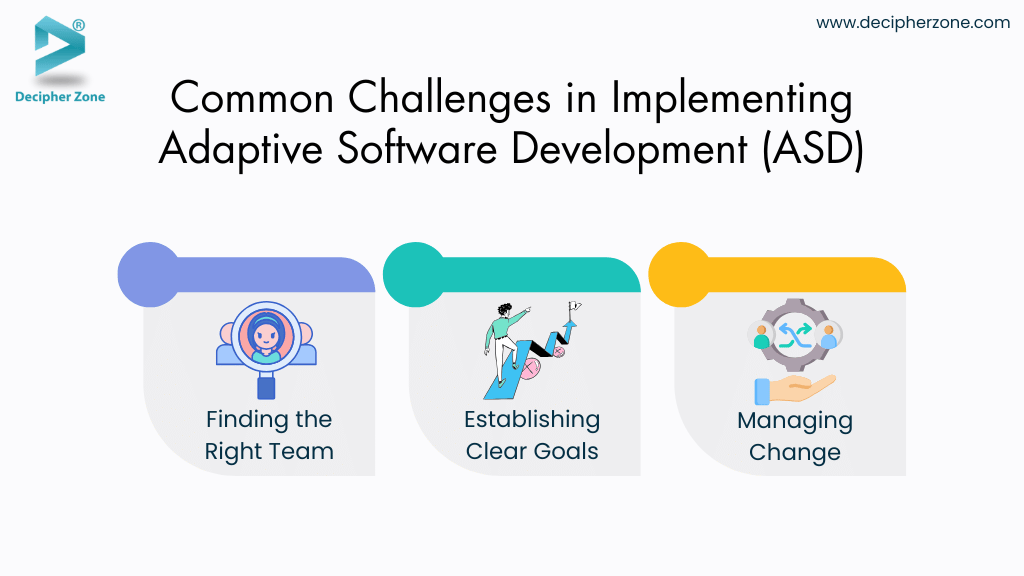
3. Managing Change
Team can be overwhelming with frequent changes in requirements which can disrupt workflows as well. ASD only thrives on embracing change when managed properly. At Decipher Zone, agile workflows are backed by agile tools, version control and CI/ CD systems that help teams respond quickly to new inputs while maintaining stability.
4. Ensuring Quality and Testing
ASD requires rigorous ongoing testing throughout the development lifecycle to ensure that the product meets the requirements. This demands not only automation but also strategic test planning. Decipher Zone employs robust testing frameworks and QA methodologies that are integrated with each iteration to catch bugs early and maintain high-quality standards.
.avif)
5. Facilitating Clear Communication
ASD requires effective communication like a glue that holds adaptive teams together. But with fast-paced iterations miscommunications can easily creep in. But not with Decipher Zone. Our team fosters a collaborative culture supported by tools like Jira, Slack and Cofluence which ensures transparency, alignment and consistent progress across all stakeholders.
6. Managing Uncertainty
ASD focuses on managing uncertainty by encouraging teams to adopt flexible strategies that can adapt to changing requirements, technologies and end user needs. This shift from traditional development models can be challenging. This makes effective leadership essential.
Teams must be trained not just to anticipate change but to expect it. Boosting open communication through regular check-ins and feedback mechanisms helps address uncertainties early that ensuring that progress remains on track.
We provide the experts with the essential mindset and infrastructure to scale in predictable settings. By implementing agile coaching, communication best practices and continuous integration pipelines. We empower businesses to transform uncertainty into a strategic advantage. This approach boosts innovation while maintaining a clear direction for the organization.
Read: Adaptive vs Responsive Design
How Decipher Zone Drives Success with Adaptive Software Development (ASD)?
Decipher Zone has a mindset that fuels agility, innovation and customer centricity in every project. Our team believes Adaptive Software Development (ASD) isn’t just a methodology.
By embracing the core principles of speculation, collaboration and learning our team is equipped to thrive in dynamic environments where requirements evolve swiftly and continual improvement is a must.
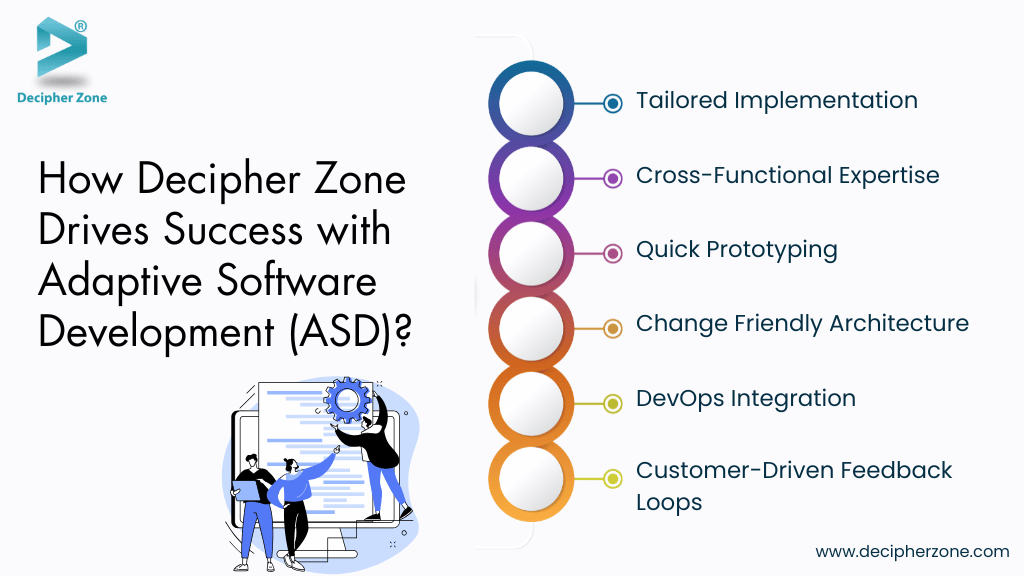
Here are the ways our team can help businesses succeed with ASD implementation:
-
Tailored Implementation: We don’t follow a one-size-fits-all approach. Our team evaluates the unique needs of your business and develops adaptive workflows that align with your goals, timeframes and resources.
-
Cross-Functional Expertise: From frontend developers to backend architects, QA testers to project managers our cross-functional teams work in tight collaboration which enables fast iteration and efficient problem solving.
-
Quick Prototyping & Incremental Delivery: We break down complex projects into manageable iterations delivering functional software early and often. This ensures faster time to market, reduces rework and keeps stakeholders engaged throughout the lifecycle.
-
Change Friendly Architecture: Change is inevitable in software projects. That is why we build flexible scalable systems that accommodate evolving business requirements without compromising quality and performance.
-
Robust Tools & DevOps Integration: Our team integrates advanced tools such as Git, Jenkins, Docker, Jira, Selenium and more to support continuous integration, delivery and automated testing which boosts the efficiency but also minimizes risks.
-
Customer-Driven Feedback Loops: Decipher Zone development process revolves around user feedback. We incorporate input at every stage to refine features, improve usability ands ensure the final product delivers value to customers.
Decipher Zone allows businesses to adapt faster, build smarter and scale confidently. With a proven track of successful ASD implementation across industries mainly finance, educational, real estate and hospitality.
FAQs
What is Adaptive Software Development (ASD)?
Adaptive Software Development (ASD) is a modern and flexible software development methodology designed for one key purpose “to embrace “ change. ASD provides a flexible, iterative and highly collaborative approach that allows development teams to respond swiftly to evolving customer needs and shifting market demands. It is a mindset that is rooted in the principles of Agile. This method encourages teams to develop software incrementally, incorporating continuous feedback and real-world insights throughout the development lifecycle.
What is the timeline for implementing ASD in the project?.
The time frame for implementing Adaptive Software Development (ASD) depends on the project’s size, complexity and team readiness. Small to mid-sized projects can adopt ASD in a few weeks to a couple of months while larger projects can take longer due to the need for training, tool setup and stakeholder alignment.
What are the key challenges of using adaptive software development?
While there are several benefits to adopting the ASD approach teams also face a unique set of challenges such as finding the right team, establishing clear goals, managing change, ensuring quality and testing, facilitating clear communication and managing uncertainty.

